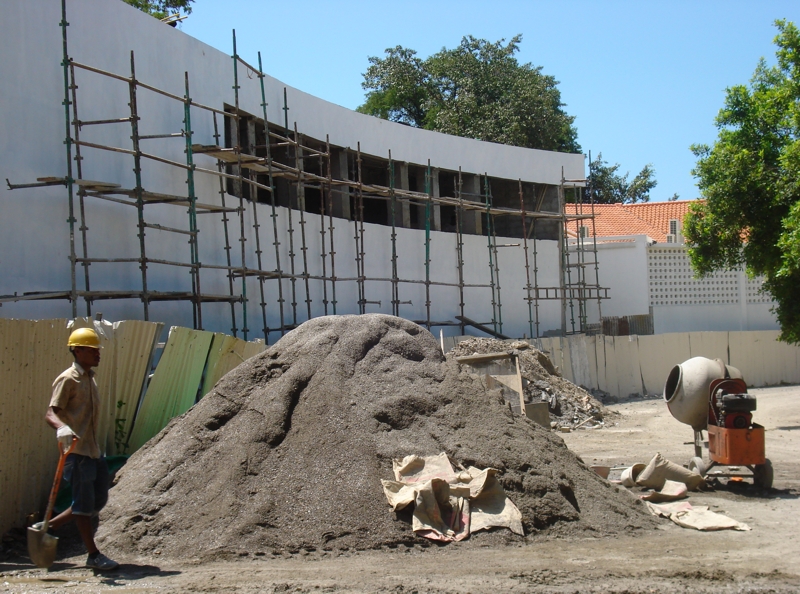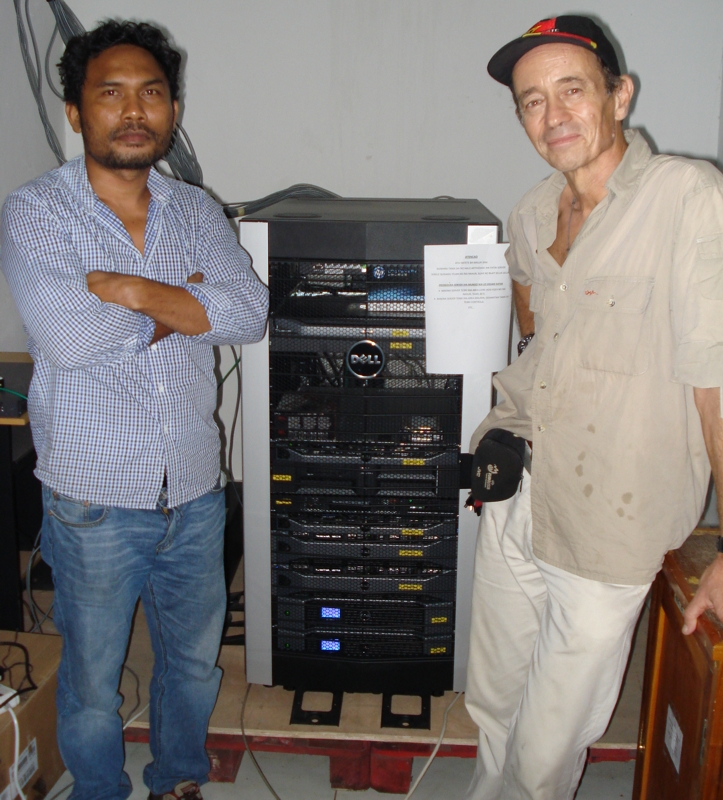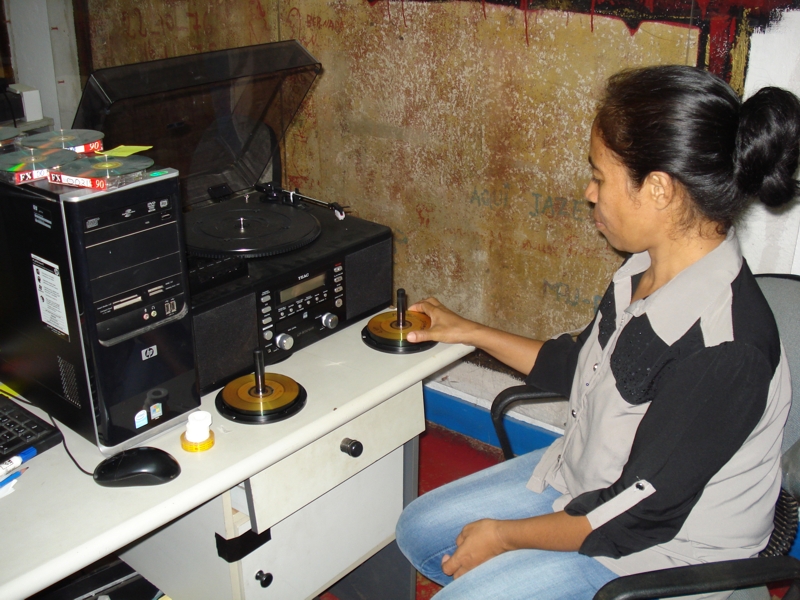CHART archivist and manager John Waddingham has just completed his fourth visit to Timor Leste to learn about archival institutional developments there. He reports continuing progress in most of the emerging archives.

Audiovisual archive building under construction in Dili. The Timorese Resistance Archive and Museum in background.
Increasing national government investment in archives in Timor-Leste is clearly driving some of the more visible advances in archive developments in the country. Since my last visit in 2011, the splendid redevelopment of the Timorese Resistance Archive and Museum (AMRT) has been completed and construction of an adjacent purpose-built audio-visual archive building is well under way.
Somewhat less visible in Dili are the important archives of Timor-Leste’s Commission for Reception, Truth & Reconciliation (CAVR) and the Arquivo Nacional which holds administration records from the Portuguese, Indonesian and independence eras.
Ten days in Dili is not sufficient time to develop an in-depth understanding of each of these institutions. But my impressions are offered here as an indicator of the direction and progress being made in this area in independent Timor-Leste.
Timorese Resistance Archive & Museum (AMRT)
Since its establishment in 2005, the AMRT has set the pace for archive developments in Timor. The Lisbon-based Fundacao Mario Soares (FMS) largely funded the original building, a large resistance documents digitisation project and online database. The Timor government-funded building redevelopment has turned the AMRT into a much-visited showcase of resistance history.
In addition to an extensive multilingual permanent exhibition, the AMRT provides several workstations for researcher access to its digital document collection and a well-equipped auditorium for events and seminars.Secure climate-controlled storage and processing areas are expected to facilitate the eventual return of resistance documents from Lisbon to Dili – an issue of considerable concern to some Timorese observers of archival developments. The AMRT is now actively soliciting for deposits of original materials from within Timor and outside.
The legal and administrative arrangements for the AMRT have progressed. In June 2014, Timor-Leste’s Council of Ministers approved a statute designating AMRT as a ‘Public Institution’, though I understand long-standing plans for a broad-based Timorese advisory board have stalled.
The AMRT, in common with all archival institutions in Timor, does not appear to yet have formally trained and qualified archivists among its staff. I believe there is a formal agreement mandating the FMS in Lisbon to continue its technical assistance and archival advice/training roles at AMRT.
Arquivo Nacional
The Arquivo Nacional was the first formal archive to be established in newly-independent Timor-Leste, but it remains the least well-known. Few people seem to be aware of its existence or location.
Since its creation to preserve records of East Timor’s administrations, most of its effort has been devoted to arranging and describing the Portuguese-era records discovered in the attic of the Palacio do Governo after the 1999 independence ballot. This work has apparently been completed to a level allowing researcher access. However, there is not yet any publicly available guide to the archives contents.
I was pleased to hear that work has now begun to examine the huge volume of Indonesian-era administration records being held in very poor conditions by the archive. A lack of suitable work space and storage areas is likely to continue to hamper this work. An even bigger problem lies in how to preserve the key records of the State of Timor-Leste since 2002. Many boxes of unsorted records from Ministries have been seen at the archive since 2009. Temporary storage in stairwells and passageways being testament to the problem.Earlier cautious leadership and static budgets since 2003, along with the absence of any public advocacy for the archive’s development, have contributed to the archive’s low profile. Compared to earlier visits, however, my 2015 impressions suggest this is about to change. There is a spring in the step of staff I spoke to; an apparent renewed sense of purpose and direction.
This change of atmosphere may be due to recent international contacts and cooperation. Archivists from the National Archive of Brasil have visited Dili several times since 2011 and produced reports and recommendations for archival development. Arising out of this process came draft legislation which defines the structure and purpose of Timor’s national archive and is expected to be finalised by June 2015.
Another important development is Arquivo Nacional work to design record-keeping systems which will be promoted and applied in all government ministries. This will facilitate the transfer from government departments of designated long-term archival materials to the Arquivo. It will also, of course, help in the development of much-needed record-keeping systems in the government ministries.
Centro Audiovisual Max Stahl (CAMS)
Continuing serious illness has not stopped Max Stahl’s ambitions for the preservation of Timor-Leste’s cultural and political audiovisual heritage. If anything, it has intensified his drive.
Never content with just preserving his own historic game-changing footage of the 1991 Santa Cruz Massacre, Max Stahl has trained many Timorese in the art of recording interviews and cultural events in independent East Timor and then preserving and providing access to the materials.
Since we last visited Max in 2011, there have been a number of ups and downs. In 2013, historic Stahl footage was inscribed on UNESCO’s Memory of the World register. However, CAMS had to move from its long-standing base in beach-side Farol and now occupies a less-salubrious unmarked building in the precinct of the national parliament, opposite the AMRT. Public controversy about the building owners’ opposition to the CAMS presence may yet require another move.
CAMS now receives significant financial support from the Timor-Leste government and has a more formal management structure than existed in earlier years. A formal relationship between CAMS and AMRT has been under construction for some time but there have been difficulties – the nature of which remain unclear and apparently unresolved.
The previously-established link between CAMS and the French national audiovisual institute, INA, continues to provide a secure, external archival storage facility. In Dili, CAMS has installed high-level computer server machinery and specialist audiovisual software to manage and provide online access to the digitised collection. Max envisages this latter development, combined with a move into the new building being constructed nearby, will pave the way for CAMS to become Timor-Leste’s national audiovisual archive.
CAVR Archives
The materials collected by Timor-Leste’s Commission for Reception, Truth & Reconciliation (CAVR) during its operation from 2002 to 2005 include a unique and irreplaceable record of personal experience of thousands of East Timorese during civil war and occupation (1975-1999). These archives are the responsibility of the Post-CAVR Secretariat which was established to protect the archive, promote the CAVR report, Chega!, and to prepare the ground for a successor organisation to continue these tasks.
The Post-CAVR Secretariat reports to the Office of the President; its funding comes from the President’s overall budget.
It is fair to say that since our visit in 2011, the Secretariat has been in a state of limbo. Legislative instruments for the establishment of a successor body (Institute of Memory) lapsed with the 2012 elections and there are few public signs that the matter has received urgent attention since. This uncertainty seems also to be reflected in the day-to-day work of the Secretariat, including the management of the archives.
There has over recent years been some disquiet from researchers about access to the archives. Unlike some overseas visitor experience, however, East Timorese researchers told me they had no trouble accessing the archives. On the other hand, these same researchers found that the lack of printed or electronic guides to the collection content made it difficult for staff to locate requested archival materials.
That said, there have been positive developments in archival preservation, including:
- Post-CAVR has established some links with Indonesia’s National Archive and recently purchased from there a large quantity of archive boxes to replace less suitable containers currently being used. It is not clear whether increased links with the Indonesian archive are planned.
- More significantly, archives staff have begun in-house digitisation of thousands of audio-cassette recordings of individual testimonies and interviews. While the processes being employed do not meet generally-recognised archival standards, they do significantly enhance the protection of these unique materials.
- A substantial number of records of CAVR public hearings have been digitised and lodged with the British Library – as a means of external backup and to facilitate access internationally.
We hope the reported interest of both the President and the new Prime Minister in establishing a CAVR follow-up institution will be acted on by the Parliament in the near future. And we hope such legislation will include clear statements on the need to preserve the archives following recognised standards, add to them and make them more easily accessible for research.
Acknowledgements
Special thanks to Margarida Mesquita and Cristina Prata for their invaluable assistance in Dili.
Many thanks to management and staff at each of the institutions for giving me the time to discuss their programs. Any opinions or errors of fact and interpretation are, of course, my responsibility alone. JW
———————————————————————–
Note: Other CHART notes on archives in Timor-Leste, including links to our 2003 and 2009 reports, can be found on this website’s Timorese Archives section.
![Fragments from the AMRT's permanent exhibition [Source: AMRT Brochure]](https://timorarchives.info/wp-content/uploads/2015/03/amrt-display.jpg?w=225)
![In the stacks: Portuguese colonial records at the Arquivo Nacional. [Source: C. Prata]](https://timorarchives.info/wp-content/uploads/2015/03/arquivo-cp.jpg?w=200)



Thanks John for continuing to keep your interest, and by extension, Timorese interest in preserving as much as possible. I am encouraged that the Timorese also are interested in preserving their past. Another sign perhaps that unification of all Timorese factions is well on the way.
John, Thanks for the update on the East Timor archive work. So much has happened for East Timor in recent years and much of the archival material is from the foundational years so is obviously very important. You and others seem to have found a way forward in recent times. Congratulations! Peter
from Peter Woodruff Editor of Australian Journal of Mission Studies (AJMS)